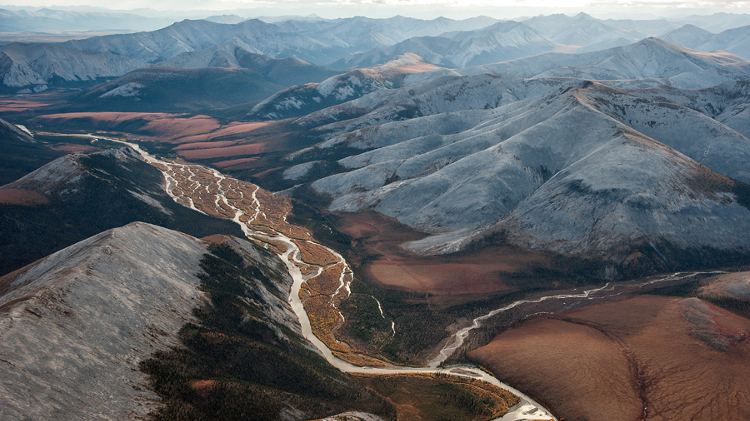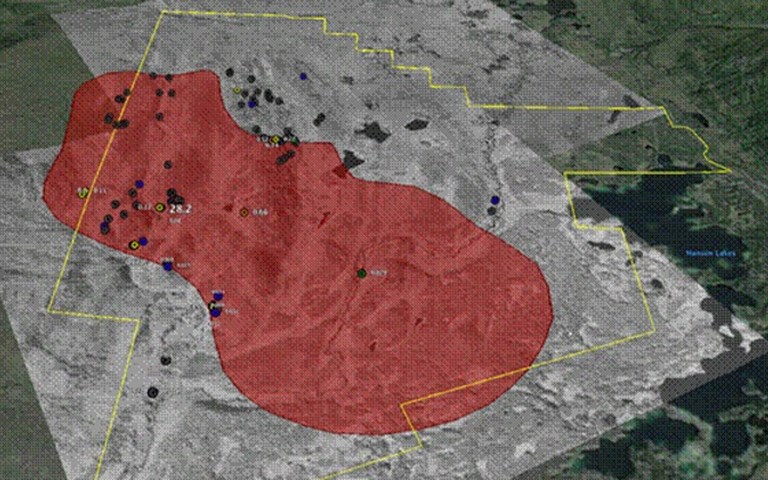The SGDS Hive team generated five targets on its test case, the McConnells Jest gold property (above) in Yukon. Courtesy of Andy Randell
A Vancouver-based geologist is hoping a new innovative opportunity will help place young geoscientists in a good position to weather the turbulent commodities market and come out on top.
Andy Randell launched a crowd consulting initiative in April as an offshoot of his independent consulting work at Strata GeoData Services (SGDS). Called SGDS Hive, the idea is to bring together recent graduates of geoscience and other specialities such as environmental science to assess exploration projects, producing comprehensive reports that highlight mineral targets as well as social and environmental issues.
The Hive concept promises to provide graduates with practical experience and deliver clients – mostly junior companies and prospectors – a quick and cost-effective means to advance their projects. Clients may also benefit from indirect access to new research and university facilities through recent graduates doing post-graduate work, as well as a broader range of expertise and potential full-time employees already familiar with the project should they ever require a permanent geoscientist.
When the junior exploration market crashed in 2012, Randell was among its first casualties. Suddenly unemployed, the former chief geologist for Ryan Gold turned to consulting to pay the bills.
“But I quickly realized I was a small fish in a very big pond,” said Randell, who graduated in environmental geoscience from Cardiff University in Wales in 1998 and has spent a large portion of his professional life on gold projects in Yukon.
Randell found part-time work in a pet store, but a trained geoscientist selling cat litter did not sit well with him.
“I don’t know exactly when the penny dropped but I thought that it would be good to have graduates working on actual projects and mentor them through the process of talking to First Nations, dealing with environmental issues as well as kicking rocks,” said Randell, who currently hires mostly graduates from B.C. universities and colleges but receives resumés from around the world.
Related: SGS Geostat won Integra Gold's Gold Rush Challenge with a combination of artificial intelligence and more conventional exploration methodologies
SGDS Hive team members work remotely, storing maps and text in Google Drive, a free cloud-based storage service that allows individuals to collaborate on projects. The team members keep track of their hours, but the schedule is flexible, allowing them to work around other employment and study commitments.
The team uses QGIS, a free open source geographic information system, for mapmaking. All the project information is password protected to ensure confidentiality, but clients can monitor developments in real time. Once a project is completed, Randell removes the information from the cloud and backs it up on a hard drive.
The test case was the McConnells Jest gold project in Yukon. Claim owner Bill Koe’-Carson wanted to narrow down targets on his 3,371-hectare property within the Tintina gold belt. The Hive team for this project, consisting of three recent graduates supervised by Randell and one GIS consultant, generated five targets based on geological interpretation of current and historical data.
When Koe’-Carson returned to the property in August, he sampled surface mineralization on all the Hive targets he was able to investigate. Assays are pending.
“This was not just a summary report incorporating data interpretation,” said Koe’-Carson. “This was clarity of vision and direction for me, in a neatly presented package. Given the chance to showcase their underutilized talents, the team seized the opportunity with a zeal rarely seen these days from more jaded veterans.”
Related: Laurentian receives historic donation for mineral exploration research program
Beyond delineating targets, the report (which follows a National Instrument 43-101 format but does not qualify as one because there was no site visit) addresses the environmental and social issues that might arise on the traditional territory of the Na-Cho Nyak Dun First Nation. The completed report was shared with the Nation.
Randell said he believed the report was appreciated by the First Nations there, adding that “they really liked the fact that Bill spoke to them and was aware of the archeological sites and rare plant species in the area.”
He sees Hive not just as an altruistic venture but as essential training for the generation of geoscientists who will replace those currently retiring or turning to other careers as the bear market for commodities growls on.
Although Randell completed the McConnells Jest report for free in exchange for the freedom to showcase the results, he is currently managing paid contracts that remain confidential for now. He pays his team members $25 per hour, basing his bids on how many hours he estimates the project will take. Most of the team members, including Randell, continue to work part-time jobs in retail.
Although Hive is only a few months old, Randell is already receiving recognition both at home and abroad. Geoscientists in Australia are interested in replicating the crowd consulting concept, while the BC Association of Professional Geoscientists and Engineers (APEGBC) has asked Randell to host the student orientation day at AME BC’s Mineral Exploration Roundup in January.
“A lot of people are looking for opportunities to learn during this downturn,” said Randell. “At some point our industry will return, and these graduates will be required to run exploration programs, so it’s important that they remain engaged.”




